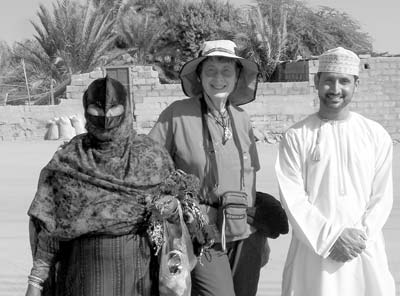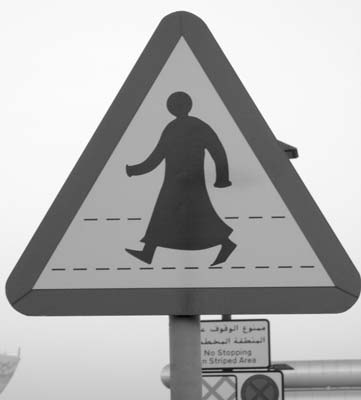UAE, Bahrain, Qatar, Oman and Kuwait with Adventures Abroad
I took a very interesting tour of the Gulf States with Adventures Abroad (1124 Fir Ave., Ste. 101, Blaine, WA 98230; 800/665-3998) and learned so much about a fascinating part of the world.
The cost for my 20-day tour in January ’07 was $4,360, land and internal air, including the 3-day pre-tour in Kuwait.
It was interesting to be in countries where the overwhelming majority of the people in each were expatriates and it was rare to meet citizens of the country. The ratios ranged from about 35% citizens to 65% expatriates (more or less) for the different countries.
The shop workers and hotel and restaurant staffs were from large expatriate communities (we met Indians, Filipinos, Egyptians, etc.), thus, as our Canadian guide explained, to see natives we would spend our lunch hours in shopping malls. There we could see men in their white robes and women in their traditional black dress at Starbucks or McDonald’s, with the children and their Indian nannies nearby. We saw shopping malls where there was a roller coaster (Qatar), an ice rink (Abu Dhabi) or even a ski lift (Dubai).
We also were amazed by the tents in the desert where locals could take their children on weekends to see what life was like in the “not so good old days” — before oil.
Besides museums, mosques, historical sites and other points of interest that all tours include, some of the interesting points of this trip were. . .
- in Kuwait, the Kuwait Towers, along with photos of what they looked like after being shelled by the Iraqis;
- in Bahrain, the many tomb sites of what was once a necropolis for the Persian empire;
- in Qatar, the luxurious horse stables and exercise pools where Arabian horses are trained;
- in Abu Dhabi, camels being trained for racing by using robots controlled by men in SUVs (there had been objections to the use of child jockeys), and
- in Dubai, having high tea at the Burj al Arab, the 7-star hotel that looks like a sail. The information I was given said that the cheapest room cost $2,000 per night.
- In Bahrain our guide said that 3½ liters of gasoline went for a dollar, while a dollar would buy only two liters of bottled water. The guide jokingly said that if they were short of water, they drank petrol.
The other emirates have not been so fortunate with oil revenues. We drove north from Dubai to Sharjah, which is a bedroom community for Dubai, our guide told us. Ajman is just a little longer commute but makes money being the alcohol supplier for the “dry” emirates. Umm al-Qaiwain remains as what the towns all were like before oil: fishing villages. Ras al-Khaimah is trying to attract the resort business but also has some interesting archaeological sites, including a castle attributed to the Queen of Sheba, although experts say it is not old enough. The last emirate was Fujairah, which we crossed on the drive to Oman and where we saw mainly desert.
After all the opulence of the Emirati wealth, Oman was a breath of fresh air. It was neat and clean. We were told that Muscat was given recognition by the U.N. for being the cleanest city (in the Middle East, that is; it is the second cleanest in the world, after Singapore, according to the U.N. — Editor). The oil money has been spent on providing roads, schools and power to the mountain and village communities.
The ratio of citizens to expatriates was just the opposite of that in the other countries, about 20% being expats. The king of Oman expects his citizens to be educated and work for a living.
Our guides there were simply delightful. One told us about growing up poor in a nomadic community and having the opportunity to go to school. Now he owns a tour company in Salalah, where he showed us the famous frankincense trees.
DORIS NEILSON
Avcoa, MI


